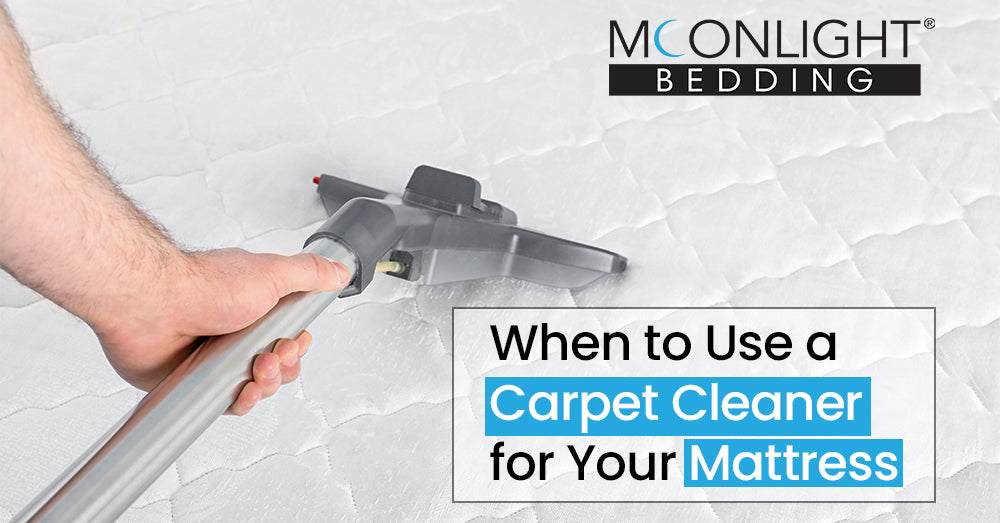There’s nothing worse than realising your mattress has an unsightly stain. Cleaning a mattress can feel overwhelming, whether from a spilt coffee, a pet accident, or the dreaded sweat and urine stains that seem impossible to remove. Many wonder, “Can I use a carpet cleaner on my mattress?” The short answer? Yes, but only if you do it correctly.
A mattress is one of the most used household items, yet it’s often neglected when cleaning. Unlike carpets and upholstery, which get cleaned regularly, mattresses absorb sweat, dead skin cells, and allergens over time, making them a breeding ground for bacteria and dust mites. A carpet cleaner might seem like the perfect solution for deep-cleaning a mattress, but there are a few things to consider before spraying and scrubbing.
In this guide, we’ll explore when it’s safe to use a carpet cleaner on your mattress, how to do it properly, and alternative cleaning methods that can keep your bed fresh and hygienic.
Can You Use a Carpet Cleaner on a Mattress?
A carpet cleaner can be an effective tool for removing stains and deep cleaning a mattress, but it depends on the mattress type and the moisture level. A carpet cleaner might be viable if you have a traditional innerspring mattress or a hybrid model. However, if you own a memory foam mattress, you must be extra cautious.
Memory foam is highly absorbent and retains moisture for a long time, which can lead to mould growth if it doesn’t dry properly. Using a carpet cleaner on a memory foam mattress can do more harm than good. Instead, use dry cleaning methods like baking soda, hydrogen peroxide, or an upholstery cleaner designed specifically for mattresses.
Another factor to consider is drying time. Unlike carpets with airflow from all sides, mattresses don’t dry as quickly. If excess moisture is left behind, it can create the perfect environment for mould and mildew. Before using a carpet cleaner, thoroughly dry your mattress, such as placing it in a well-ventilated area with fans or using a dehumidifier.
When to Use a Carpet Cleaner on a Mattress?
Using a carpet cleaner on your mattress can be beneficial in certain situations. A carpet cleaner might be your best bet if you have stubborn stains that won’t come out with traditional spot-cleaning methods. This is especially true for urine, sweat, and food spills that have seeped into the mattress fibres.

If your mattress has been subjected to pet accidents, a carpet cleaner can help eliminate the stain and the odour. Many carpet cleaners have built-in deodorising solutions that work well on mattresses, removing lingering smells that can be hard to eliminate with household cleaners alone.
However, it’s important to use the right cleaning solution. Some carpet shampoos contain harsh chemicals that may be unsafe for sleeping surfaces. Always check the label and opt for non-toxic, hypoallergenic solutions that won’t cause skin irritation or respiratory issues. If unsure, you can create your cleaning solution using natural ingredients like vinegar and baking soda.
How to Use a Carpet Cleaner on Your Mattress?
If you’ve decided to use a carpet cleaner on your mattress, following the correct method is crucial to avoid damage and ensure a thorough cleaning.
Step 1: Vacuum the Mattress
Before using a carpet cleaner, removing dust, dirt, and debris from the mattress surface is essential. Use a vacuum cleaner with an upholstery attachment to remove dust mites, pet hair, and other particles that could mix with the cleaner's moisture and create a mess.
Step 2: Spot-Treat Stains
Before deep cleaning, pre-treat stubborn stains with a stain remover. You can use hydrogen peroxide and dish soap to make a commercial upholstery cleaner or a DIY stain remover. Gently blot the stained area with a cloth to lift the stain before proceeding to the next step.
Step 3: Apply the Carpet Cleaner
Use a carpet cleaner with an upholstery attachment to avoid over-wetting the mattress. Apply the cleaning solution in small sections, working in circular motions. Avoid soaking the mattress, as too much moisture can lead to mould growth.
Step 4: Allow the Mattress to Dry Thoroughly
One of the most important steps is ensuring your mattress dries completely before using it again. To speed up the drying process, leave it in a well-ventilated room with windows open, place fans around it, or use a dehumidifier. Avoid using the mattress until fully dry to prevent mould and mildew.
Alternative Mattress Cleaning Methods
If you don’t want to use a carpet cleaner, there are several other effective ways to clean your mattress.

Steam Cleaning
Using a steam cleaner is an excellent way to sanitise your mattress and kill dust mites without excessive moisture. Steam cleaning can break down stains and deodorise the mattress without using chemicals.
Baking Soda & Vinegar
Baking soda is a natural odour absorber that can help freshen a mattress. Sprinkle it over the surface, leave it for an hour, and vacuum it up. For stains, a vinegar and water solution can help break down grime and kill bacteria.
Hydrogen Peroxide for Stains
A mixture of hydrogen peroxide, dish soap, and baking soda is highly effective for treating sweat and urine stains. Apply the solution to the stain, dry it, and vacuum off the residue.
How to Keep Your Mattress Clean & Stain-Free?
Preventing stains in the first place is the best way to keep your mattress clean. Using a waterproof mattress protector can protect against spills and accidents, extending the life of your mattress. Washing your bedding regularly helps prevent sweat and dirt buildup, while airing out your mattress keeps it fresh.

Vacuuming your mattress at least once a month removes dust mites and allergens, and spot-cleaning stains as soon as they occur prevent them from setting in. With the right care, your mattress can stay in top condition for years.
FAQs
How often should I clean my mattress?
It’s recommended that you clean your mattress deep at least twice a year. However, cleaning it more frequently can help reduce allergens and bacteria if you have allergies or pets.
Can I use a carpet cleaner on a memory foam mattress?
NMemoryfoam should not be soaked with liquid, as it absorbs moisture and takes a long time to dry. Instead, opt for dry cleaning methods like vacuuming, baking soda, or an upholstery cleaner specifically designed for memory foam.
What’s the best natural mattress cleaner?
A mixture of baking soda and vinegar is one of the best natural cleaning solutions for mattresses. It removes stains, neutralises odours, and is safe for all mattresses.
Is professional mattress cleaning worth it?
Hiring a professional cleaning service can be a great investment if your mattress has deep-set stains or odours that won’t go away. Professionals use high-powered steam cleaners and specialised solutions to deep clean your mattress without damaging it.
What’s the best way to keep a mattress fresh?
Regular vacuuming, using a terry towel mattress protector, washing bedding weekly, and air-drying your mattress in the sun occasionally can keep it fresh and free from dust mites and allergens.
A clean mattress means a better night’s sleep, so don’t neglect this essential part of your home!



